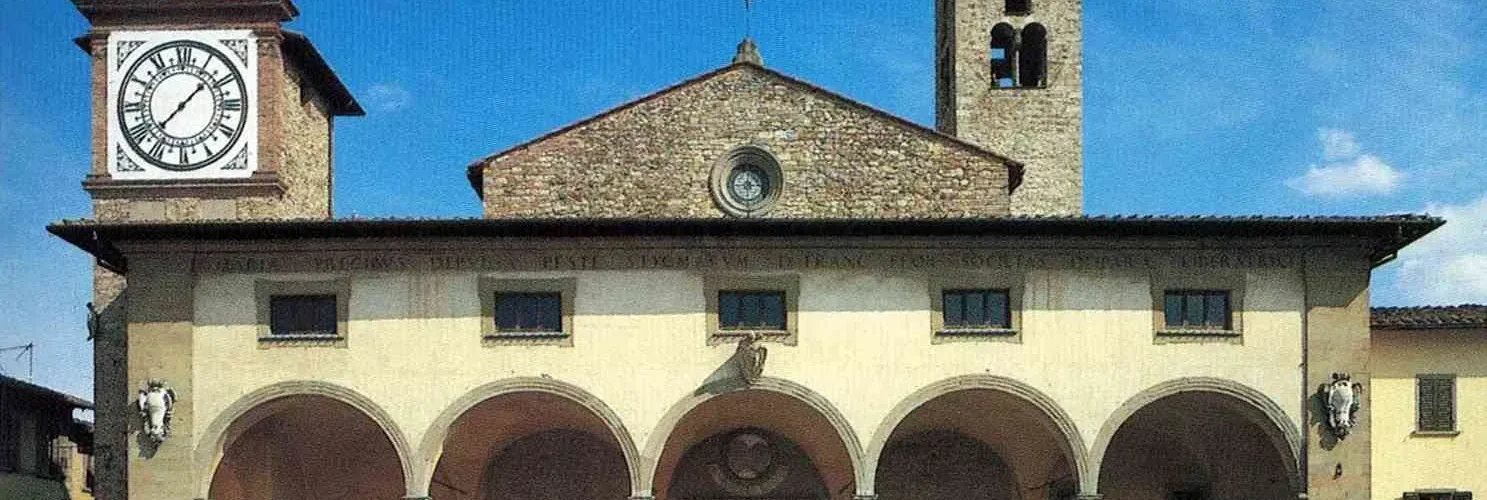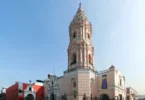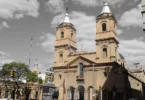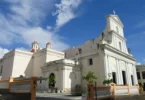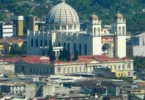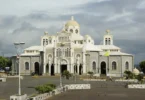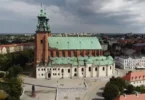Introduction
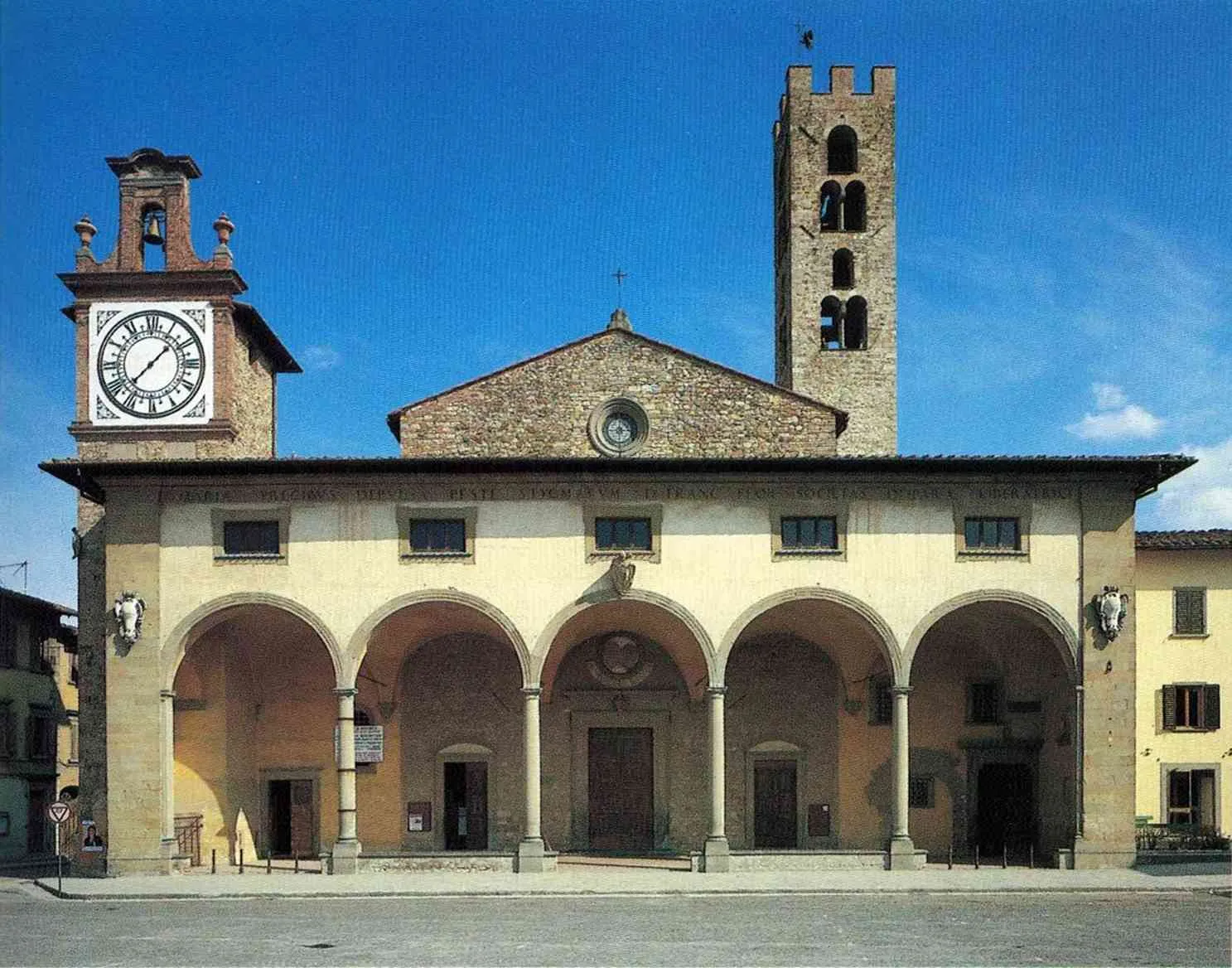
The Sanctuary of Santa Maria dell’Impruneta is a significant religious site located in the town of Impruneta, within the province of Florence. Revered as one of the most important sanctuaries in the Florentine countryside, it holds immense cultural and spiritual value due to its veneration of the Madonna dell’Impruneta. This image of the Madonna is associated with numerous miraculous events and is believed to have played a protective role for the city of Florence over the centuries. Historically, the sanctuary has enjoyed the patronage of noble families, most notably the Buondelmonti family, and was frequently enhanced by the Medici and Lorraine Grand Dukes. Their support contributed to the creation of a remarkable structure, making it one of the most splendid basilicas within the Grand Duchy of Tuscany.
In 1944, however, the sanctuary suffered devastating damage when it was struck by a bombing during World War II, leaving the interior in ruins. After the war, efforts were made to restore the basilica, and the decision was made to rebuild it in a more restrained neo-Renaissance style, marking a shift from its original design. Despite the destruction, the sanctuary’s rich collections of art and religious treasures were carefully preserved. Today, many of these invaluable items are displayed in the adjacent Museum of the Treasure of Santa Maria dell’Impruneta, offering visitors a glimpse into the sanctuary’s storied past and its cultural significance.
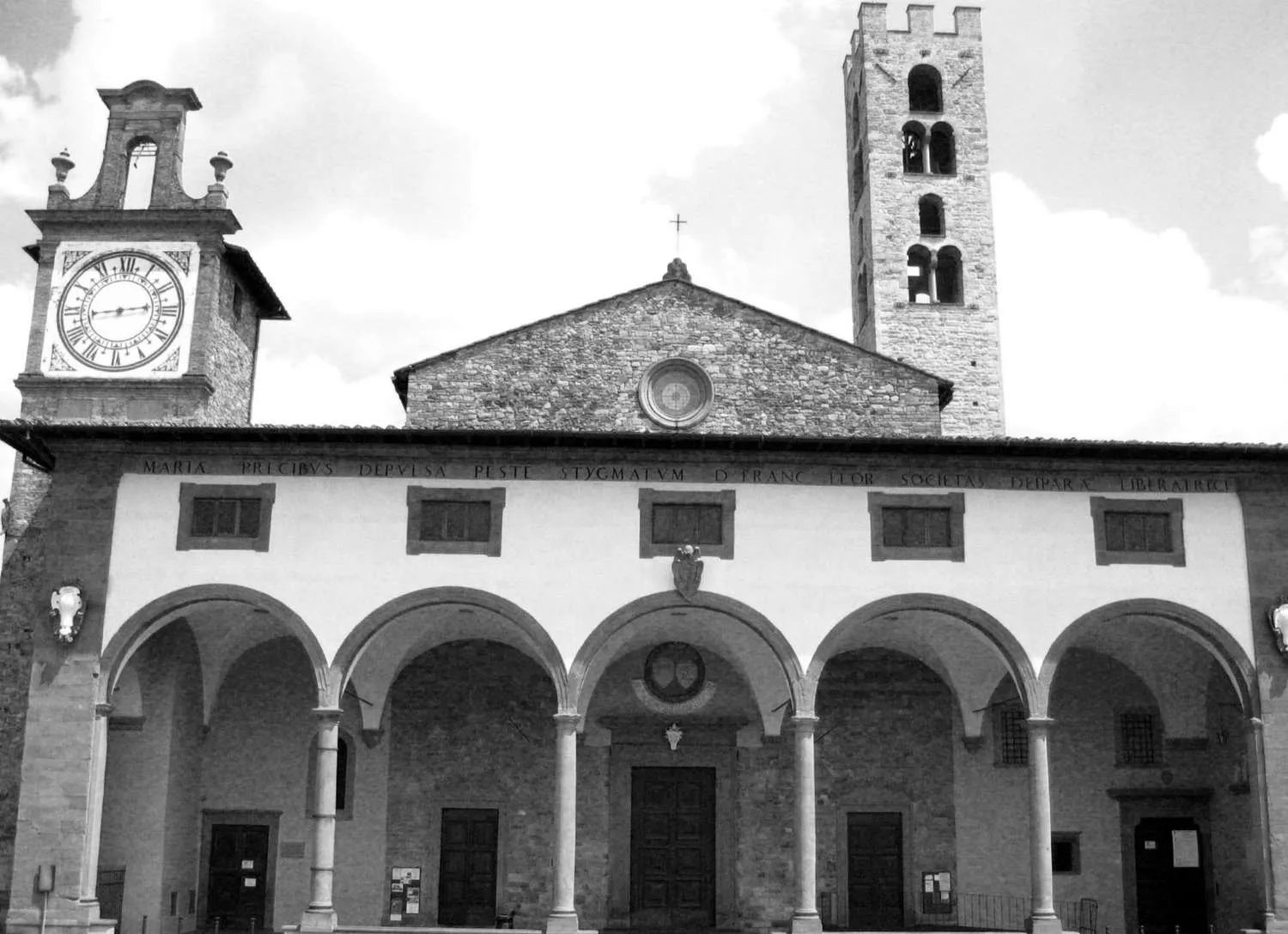
The Sanctuary of Santa Maria dell’Impruneta is rich in history, beginning with the miraculous discovery of the sacred image of the Madonna. Legend has it that when the people of Impruneta set out to build a church dedicated to the Virgin Mary, the walls they constructed each day would mysteriously collapse overnight. In an effort to resolve the issue, the stones were transported by cart, but the oxen pulling the cart stopped and knelt in a particular spot. When the workers dug there, they uncovered the miraculous image of the Madonna. This story became a central theme in the sanctuary’s history and was immortalized in a fifteenth-century bas-relief by Pasquino da Montepulciano, which later served as the iconographic model for engravings of the Virgin.
Early Foundations
The Santa Maria all’Impruneta church was originally a parish church, constructed along an ancient road that passed through the area, situated over a former pagan religious settlement. The location is significant because it sits atop a site that was likely used in pre-Christian religious rituals. Though there was an earlier mention of the church in a fabricated donation of land to the Abbey of Nonantola in 774 by Charlemagne, the first true historical record is a document from 1032, in which goods were offered to a religious community at a site referred to as “infra teriturio de plebi sancte Marie sito Pinita,” meaning “within the territory of the people of Santa Maria at Pinita,” written in the Badia Fiorentina. The church was formally consecrated on January 3, 1059, by Pope Nicholas II, with a possible significant renovation at the time of consecration. A notarial deed was also recorded in 1074, further confirming the church’s established role in the local religious community. Over the centuries, the church gained recognition as a spiritual hub, receiving significant patronage and benefits from local and regional powers.
Growth and Prosperity
By the 12th century, the church had grown in prominence and was the seat of a chapter of priests. Pope Nicholas II granted special privileges to the parish, which were reaffirmed in 1156 by Pope Adrian IV. These privileges signified the church’s growing importance within the region. The church’s prosperity is further evidenced by the tithes paid in 1276 and 1302, which exceeded one hundred lire, indicating that the parish was wealthy and influential. In 1291, Pope Nicholas IV granted additional privileges to the parish, further solidifying its place in religious and civic life. A significant event occurred in 1331, when Pope John XXII attempted to transfer the control of the parish to Cardinal Orsini, ignoring the rights of the Buondelmonti family, who were the church’s primary patrons. However, the local population rejected this papal decision, and the cardinal was forced to take refuge in the bell tower of the church after being chased out by the armed townspeople incited by the Buondelmonti family.
14th and 15th Century Developments
In 1340, Stefano Buondelmonti, the parish priest, founded the Compagnia della Beata Vergine Maria and initiated significant reconstruction and expansion work to enhance the church. This work continued throughout the late 14th century, culminating in the completion of the expanded church by the end of the century. The 15th century saw further expansion under the guidance of Antonio degli Agli, who served as parish priest from 1439 to 1477. To accommodate the growing community, the church underwent fortification, and a small cloister was added. The work was completed in 1468, and the project earned a papal indulgence for the parish. In 1591, the Buondelmonti family built a burial ground next to the church crypt, marking their ongoing influence and involvement in the church’s development. In 1593, they financed the construction of two chapels on either side of the choir, further enriching the church’s interior.
Baroque and Modern Enhancements
A significant architectural addition to the church was the portico on the façade, built in 1634 by Gherardo Silvani, one of the leading architects of the Baroque period in Florence. Between 1653 and 1670, the square in front of the church was redesigned with the addition of loggias, enhancing the church’s grandiosity and its visual connection to the surrounding area. In 1718, the church’s wooden ceiling was reconstructed by Alessandro Saller. Further restoration work took place between 1891 and 1893, but these efforts were marred by the devastating earthquake of 1895, which caused considerable damage to the church. The earthquake affected the loggia in front of the façade, the apse arch, and the bell tower, leading to the collapse of several sections of the church.
20th Century Destruction and Restoration
The church suffered catastrophic damage during World War II. On the night of July 27–28, 1944, the church was bombed, and the ceiling collapsed, with almost the entire central nave destroyed. The small temple of the Madonna also sustained heavy damage, though the sacred image had been safely transferred to Florence earlier, ensuring its protection. In the years following the war, significant efforts were made to restore the church. Architect Guido Morozzi oversaw the restoration, which was completed in 1955. During this time, the church’s crypt was also repaired.
The Cult of the Virgin of Impruneta
The veneration of the Madonna dell’Impruneta, while not associated with specific miraculous events, has become deeply ingrained in local devotion, making the church one of Italy’s most important Marian sanctuaries. The cult of the Madonna dell’Impruneta is particularly significant in Tuscany and is believed to have roots in an older, local pagan worship tradition. Archaeological excavations in the area have revealed evidence of a sanctuary dedicated to water worship in the Etruscan period, with the site being connected to a miraculous spring that was closed in 1445. By the latter half of the 14th century, the Madonna dell’Impruneta became widely recognized as a protector of water, particularly after the devastating flood of the Arno River on November 4, 1333. The Madonna’s intercession was sought to regulate rainfall and prevent further flooding. The first procession of the Madonna to Florence took place in 1354, and thereafter, the image was frequently carried in procession from Impruneta to the Florentine church of San Felice in Piazza. These processions were often accompanied by the most prominent Florentine magistrates and clergy, with the Madonna being exposed for public veneration in Piazza della Signoria. Notable historical records of these processions exist in the chronicles of Matteo Villani (1354), Luca Landucci (1444), and Bernardo Segni (around 1550), with a particularly significant procession held in 1529 before the Imperial siege.
The Iconography of the Madonna dell’Impruneta
The image of the Madonna dell’Impruneta has been surrounded by mystery and legend. It is traditionally attributed to St. Luke the Evangelist, who is believed to have painted many sacred images. According to legend, the image was brought to Italy by sea from the East and hidden during periods of persecution, only to be rediscovered in the fields surrounding Impruneta. The original image, however, is believed to have been painted by an anonymous 11th-century Florentine artist, known as Luca Santo, due to his deep devotion. Some scholars suggest the original image may have been a terracotta bas-relief rather than a painting.
In the mid-18th century, the image had become so faded and damaged that it was barely legible. In anticipation of a visit by the Count of Richecourt, the Lorraine regent for Tuscany, the parish priest feared that the count would reject the cult if he saw the image in its deteriorated state. Consequently, painter Ignazio Hugford was commissioned to restore the image, using the Madonna mosaic in the Florence Baptistery as a reference. This restoration allowed the cult to continue and helped preserve the Madonna’s significance in the community, with the image being displayed publicly on numerous occasions. The cult of the Madonna dell’Impruneta continues to thrive today, particularly during the October fair in Impruneta, a major religious and cultural event that draws thousands of visitors and devotees from across the region.
Architecture of Sanctuary of Santa Maria dell'Impruneta, Italy
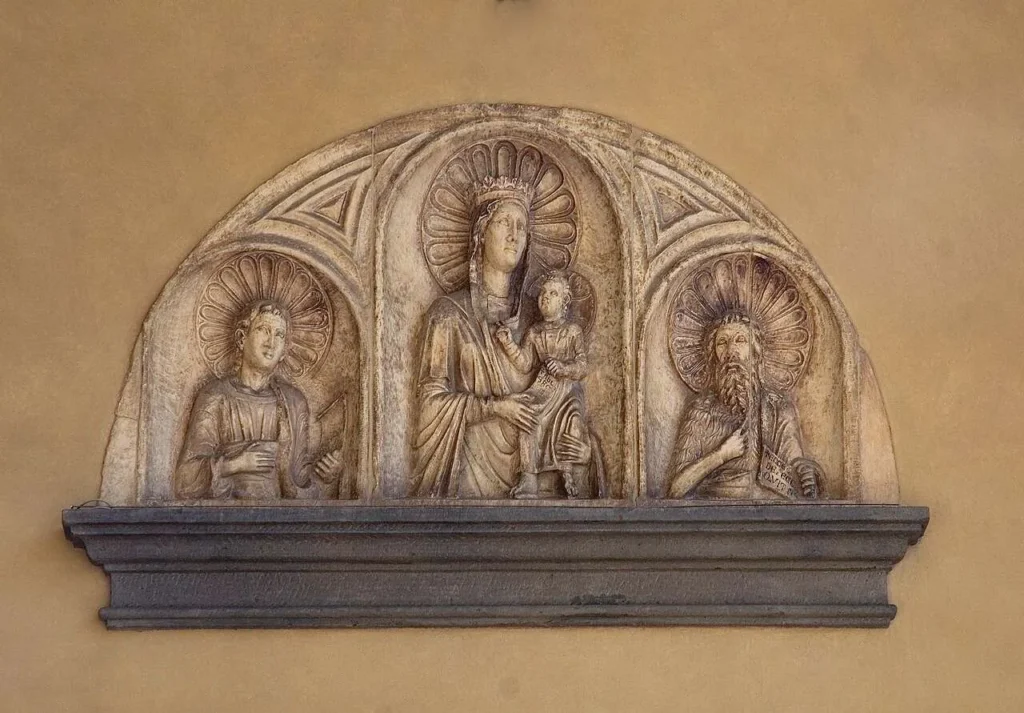
Exterior of the Sanctuary
The current external appearance of the Sanctuary of Santa Maria dell’Impruneta reflects the major transformations made in the second half of the 14th century. Under the leadership of Parish Priest Stefano, the church was enlarged due to the growing fame of the Madonna dell’Impruneta. This enlargement expanded the church to the left side, creating a single-nave plan.
Portico and Facade
The facade of the sanctuary is distinguished by a portico, which was designed and built in 1634 by Gherardo Silvani. The portico was constructed in gratitude for the intervention of the Madonna, believed to have helped defeat the plague epidemic of 1630. Above the portico, there is a hall also designed by Silvani, adding grandeur to the building’s exterior. On the left side of the church stands a turret from the 18th century with a clock, while the right side features a crenellated bell tower dating back to the 13th century. The bell tower is one of the few remaining parts of the original Romanesque parish church. The tower’s lower half has no openings except for the base portal, while the upper part is marked by rows of single- and double-lancet windows, separated by monolithic columns. The top of the bell tower was restored in the 19th century, with the addition of crenellations. Inside the portico, several plaques commemorate the consecration of the church in 1059-1060, and its later re-consecration in 1950. Additionally, a 13th-century sculpture of the Madonna and Child is displayed, along with coats of arms representing the Buondelmonti family (15th century) and Pope Leo X, celebrating his visit to the sanctuary in 1515.
Interior of the Sanctuary
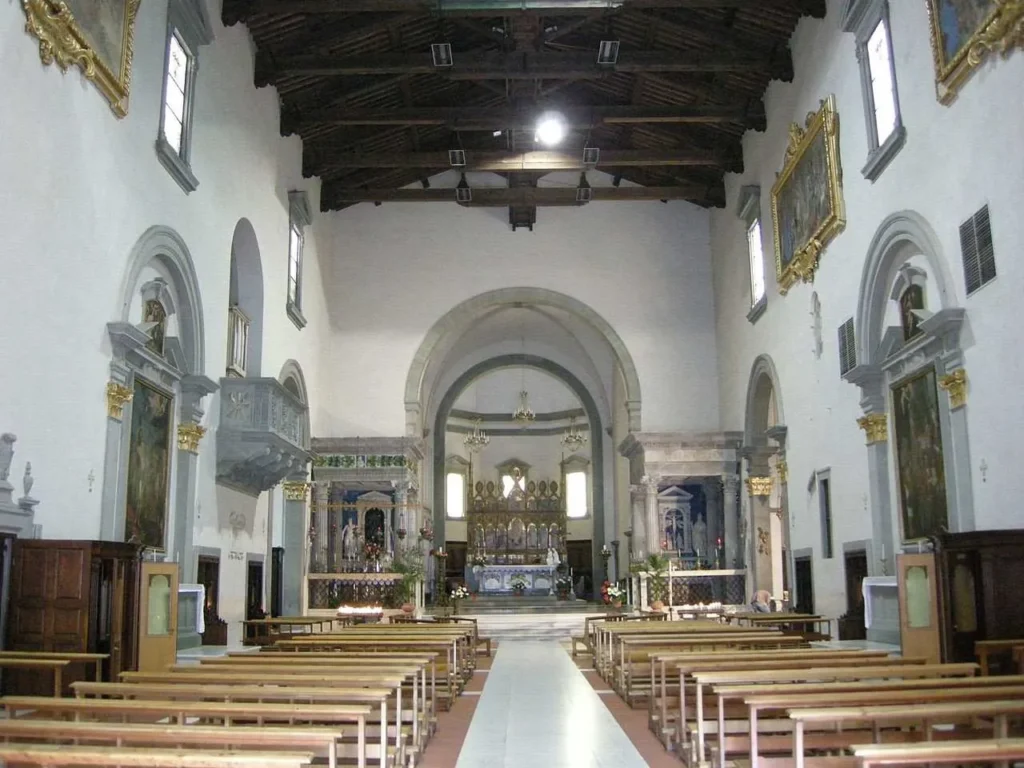
The interior of the church features a single-nave layout, rebuilt in the Renaissance style after being nearly destroyed in the bombing of 1944 during World War II. In the rebuilding process, many Baroque elements, such as the 18th-century carved wooden ceiling, were not restored. The organ, constructed between 1532 and 1535 by Fra Bernardo di Argenta, and the choir (1717–1722) are located in the counter-façade. Near the entrance, there are two marble stoups — one dating to 1542 and the other to 1637.
The church has four altars along the nave:
- First altar on the right: Contains the Martyrdom of Saint Lawrence, painted by Cosimo Gamberucci.
- Second altar on the right: Displays the Nativity of the Virgin, a work from 1602 by Passignano.
- First altar on the left: Features the Calling of Saint Peter, painted in 1606 by Empoli.
- Second altar on the left: Showcases the Martyrdom of Saint Sebastian, a work from 1618 by Matteo Rosselli.
On the right side of the church is the tomb of the parish priest Antonio degli Agli, which consists of a marble tomb surmounted by a tondo with the Madonna and Child, attributed to the workshop of Benedetto da Maiano. Five of the eight 18th-century paintings depicting the miracles of the Virgin have been relocated to the church. The paintings include:
- Cattle Plague by Giovanni Domenico Ferretti.
- Discovery of the Sacred Image and Procession in Florence by Pietro Santi Bambocci.
- Cessation of a Continuous Rain (also by Ferretti).
- Battle by Pietro Pertichi.
Baptistery
Located after the first altar on the left, the baptistery contains a baptismal font from 1590, a canvas depicting the Baptism of Christ from the 16th century, and a relief of the Baptism of Christ on the font, which is attributed to an earlier 14th-century work.
High Altar
The high altar, made from white and green marble, is of Romanesque origin and is decorated with a polyptych dated 1375–1384, attributed to Pietro Nelli with the collaboration of Niccolò di Pietro Gerini. The polyptych, which depicts the Madonna with Child and Apostles, was seriously damaged during World War II but has since been restored. The cusps of the polyptych show Stories of the Virgin, while the predella illustrates Stories of Christ.
Choir Stalls and Chapels
In the presbytery of the Sanctuary of Santa Maria dell’Impruneta, the choir stalls are notable for their exquisite inlaid woodwork, dating back to 1522. These stalls are a beautiful example of Renaissance craftsmanship and contribute to the sanctuary’s rich interior design.
The sanctuary also houses two significant chapels, referred to as the choirs, each with its own unique artistic and historical features:
First Choir: This chapel features a stunning Trinity (1418) by Mariotto di Nardo, a masterpiece of Renaissance art. It also displays the Bull of Pope Leo X from 1513, which marks an important ecclesiastical document from the period. The stalls in this choir date to the 16th century, complementing the historical significance of the artwork.
Second Choir: The second chapel is adorned with a powerful Crucifix by Felice Palma. It also includes a grate created by Cosimo Merlini and a sepulchral monument dedicated to Bishop Antonio degli Agli, dating back to 1470. These elements add both artistic and historical depth to the sanctuary, emphasizing the connection between religious devotion and artistic achievement throughout the centuries.
Temples and Chapels
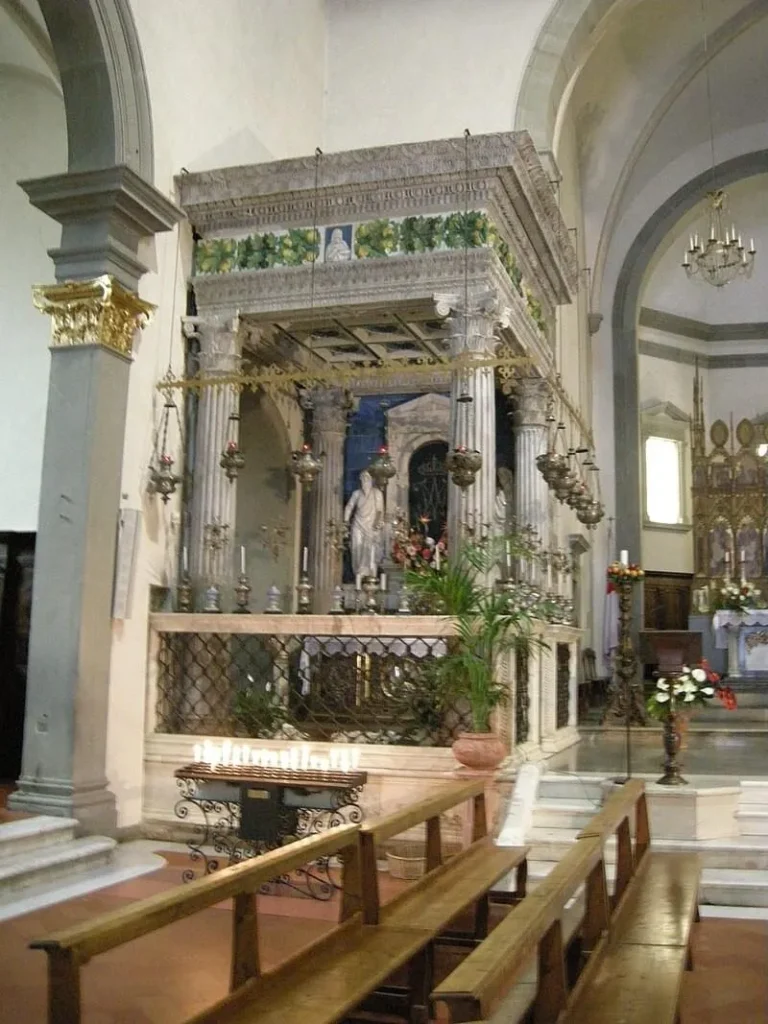
Little Temple of the Madonna
This chapel on the left side houses the sacred 13th-century panel of the Madonna dell’Impruneta, which was largely repainted by Ignazio Hugford in 1758. On either side of the Madonna are terracotta sculptures by Della Robbia, depicting Saints Peter and Paul. The altar is adorned with a silver ciborium, with a depiction of the Finding of the Sacred Image in the center. The silver antependium is a gift from Cosimo III, made in 1714 by the grand ducal goldsmiths Cosimo Merlini the younger and Bernardo Holzmann, based on designs by Giovan Battista Foggini.
Little Temple of the Blessed Sacrament
Located on the right side of the sanctuary, this chapel is also known as the Chapel of the Cross because it housed a relic of the True Cross, donated by Pippo Spano, a leader of the Scolari family, related to the Buondelmonti family. The altar features a terracotta relief by Della Robbia, depicting the Crucifixion, with statues of St. John the Baptist and St. Romulus on either side. Adjacent to this chapel is a gilded bronze grate, created by Cosimo Merlini the Elder in 1636.
Company of San Sebastiano
The Company of San Sebastiano can be accessed through a corridor located between the first and second altars on the left aisle. The altar of the company contains a panel depicting the Madonna with Saints Rocco, Sebastiano, and the brothers, painted by Giovanni Bilivert.
Cloisters
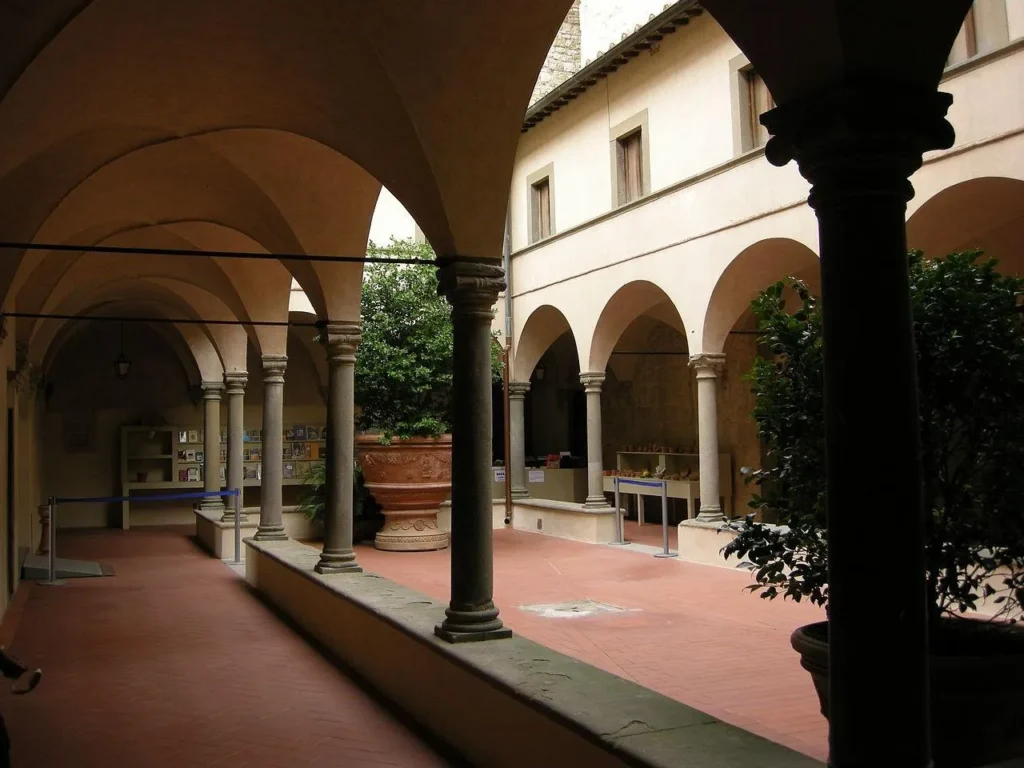
The sanctuary has two important cloisters:
First Cloister
Built during the parish of Antonio degli Agli, this cloister is designed in the style of Michelozzo.
Second Cloister and Crypt
The second cloister is older, dating to the 14th century. From here, you can access the Buondelmonti Arms Hall, a large vaulted room. The crypt, located beneath the central area of the presbytery, is a small apsidal room divided into three naves, with sandstone columns topped with capitals. Remains of a 12th-century pulpit were discovered here during restoration work after World War II.
Buondelmonti Family Burial Ground
From the crypt, visitors can access the Buondelmonti family burial ground, which was constructed in 1611. The burial niches are designed to hold the bodies of the deceased in a seated position. The sanctuary’s rich history, architecture, and artwork make it a significant religious and cultural landmark, reflecting centuries of devotion to the Madonna dell’Impruneta and the many families and artists who contributed to its legacy.
Feast Day
Feast Day: 08 September
The feast day of the Sanctuary of Santa Maria dell’Impruneta is celebrated on September 8th, which coincides with the Nativity of the Virgin Mary. This day is significant in the sanctuary’s devotion to the Madonna dell’Impruneta, and the celebration often includes a special procession, religious events, and festivities in honor of the Virgin Mary.
Church Mass Timing
Monday : 8:00 AM
Tuesday : 6:00 PM
Wednesday : 10:00 AM
Thursday : 6:00 PM
Friday : 6:00 PM
Saturday : 6:00 PM
Sunday : 8:00 AM ,11:00 AM , 6:00 PM
Church Opening Time:
Monday : 7:30 am – 11:30 am
Tuesday : 4:00 pm – 06:30 pm
Wednesday : 7:30 am – 11:30 am
Thursday : 4:00 pm – 06:30 pm
Friday : 4:45 pm – 06:30 pm
Saturday : 7:30 am – 12:00 pm., 4:45 pm – 7:00 pm
Sunday : 7:30 am – 12:00 pm., 4:45 pm – 7:00 pm
Contact Info
Address :
Piazza Buondelmonti, 50023 Impruneta FI, Italy.
Phone : +393294929871
Accommodations
Connectivities
Airway
Sanctuary of Santa Maria dell’Impruneta, Italy, to Florence (FLR) Airport distance between 28 min (23.1 km) via A1/E35.
Railway
Sanctuary of Santa Maria dell’Impruneta, Italy, to Florence’s Main Train Station distance between 36 min (25.2 km) via A1/E35.

